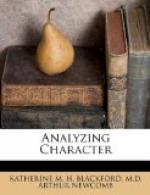Even the most casual observer notes the differences between the man with coarse hair, coarse skin, rugged features, large, loosely-built limbs, hands and feet, and the man with fine skin, silky hair, delicate, regular features, slender limbs, and finely moulded hands and feet. The individual of fine texture is sensitive and naturally refined. He loves beauty. He does his best work when he is creating something or handling something which is fine and beautiful. The coarse-textured individual is strong, vigorous, virile, and enduring. He can do hard, unpleasant work, can go through hardships, and can remain cheerful even in the midst of grimy, unpleasant and unlovely surroundings. For these reasons, fine-textured people do their best work in such lines as art, literature, music, jewelry, dry goods, millinery, and fine, delicate tools, machinery and materials; while we must rely upon coarse-textured people to do the heavy, hard, rough, pioneering and constructive work of the world. Even in art and literature coarse-textured people produce that which is either vigorous and virile or gruesome and horrible.
Because of their refined sensibilities, fine-textured people usually sympathize with the classes, the aristocracy; the coarse-textured people with the masses. It is a remarkable fact that practically all of our great liberators, radicals and revolutionists have been and are men of coarse texture. There is a great scientific truth underlying the saying amongst the people that certain ideas or books are “too fine-haired” for them.
PROPORTION
One of the most important of all the nine fundamental variables is proportion. This refers to proportion of one part of the body to another, of one part of the head to another. Each part of the body and of the head has its own particular function. Nature is orderly and systematic in all her work. She does not, therefore, try to digest food with the feet or pump blood with the hands. She does not try to use our stomachs as means of locomotion. Neither does she try to make us think with the backs of our heads.
No one needs to be told that the long, slender, wiry legs of the deer were made for swiftness, or that the huge, square, powerful jaw of the bulldog was made to shut down with a vise-like grip that death itself can scarcely relax. These are crude examples of proportion. In our study and research we have learned to associate many fine gradations of differences in proportion with their corresponding differences in mental aptitudes and character.
EXPRESSION
Everything about a man indicates his character. Color, form, size, structure, texture, consistency, and proportion indicate almost entirely the man’s inherent qualities. It is important for us to determine, however, in sizing up men, what they have done with their natural qualifications. This we do by observing Expression and Condition.




